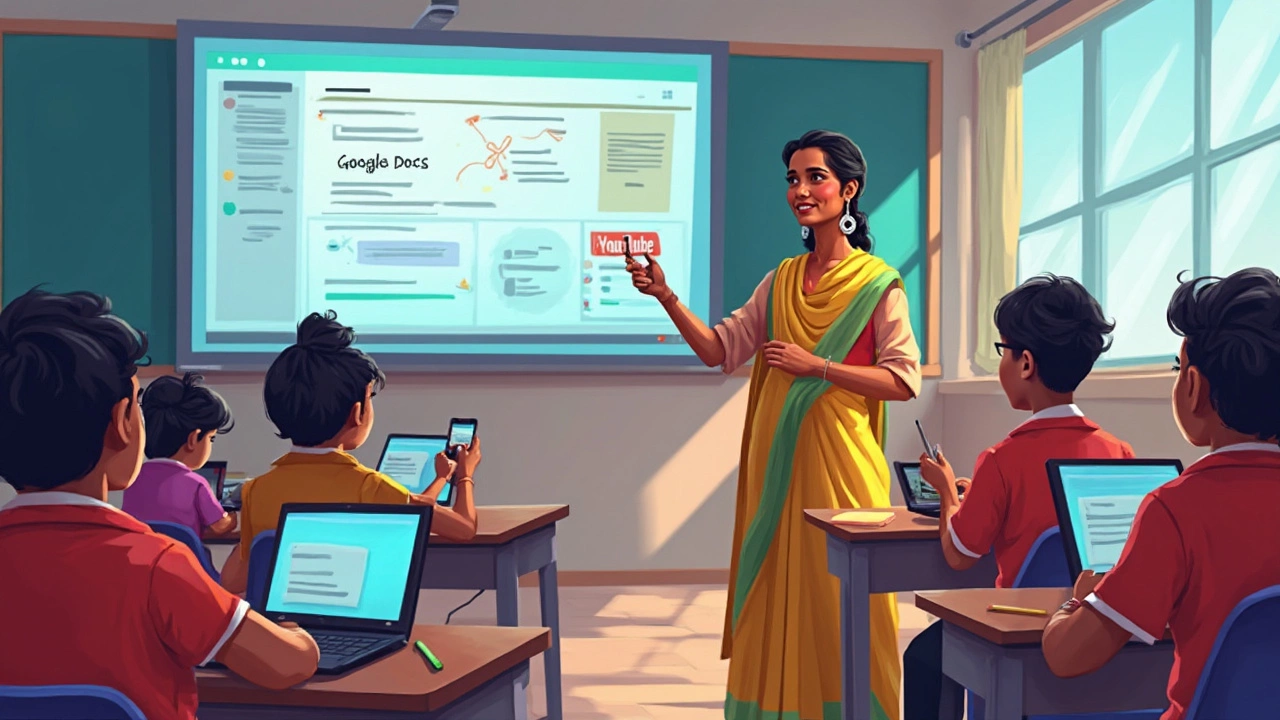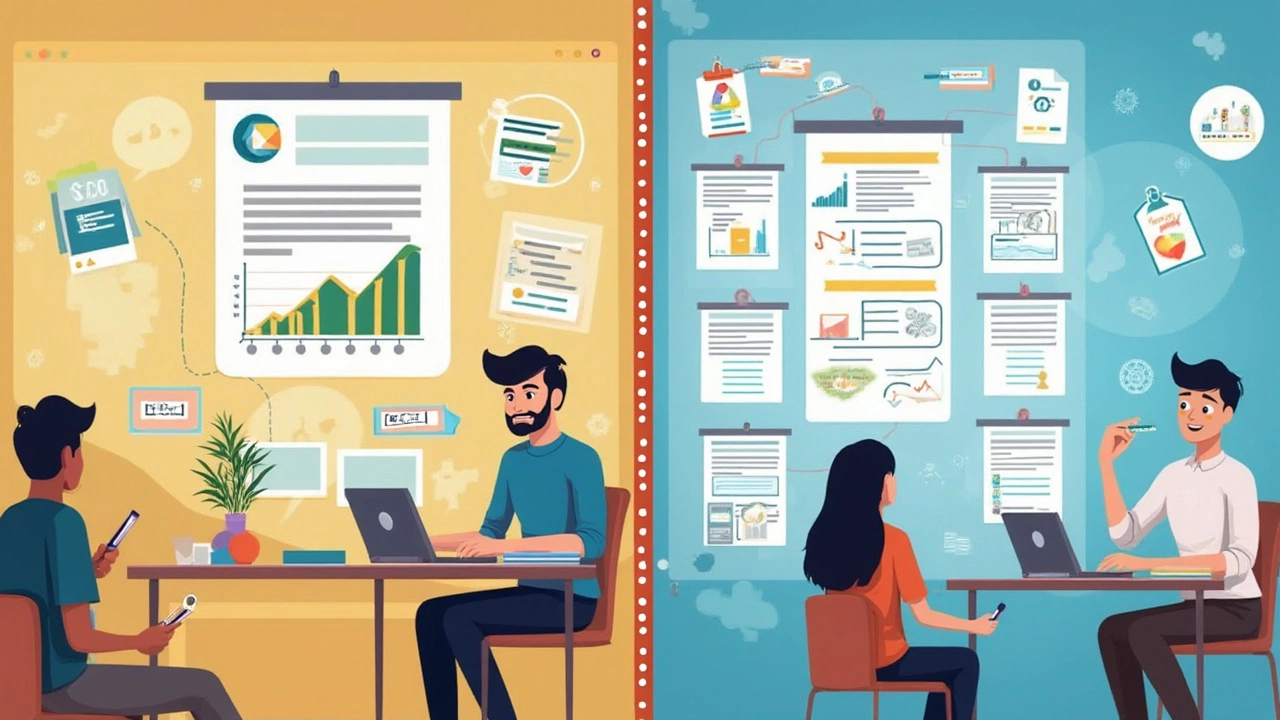
People lump Google into the e-learning world all the time, but is that actually correct? Maybe you use Google Docs for assignments or dive into YouTube tutorials when you're stuck. But being a handy tool isn't the same as being a true e-learning platform. Let's clear up the confusion so you don't waste time using the wrong tools for your own learning—or teaching.
Here's something you might not know: a real e-learning platform isn't just a place you find information. It needs to organize lessons, track progress, sometimes even hand out certificates, and let teachers manage students. Google has some of those features, but does it really check all the boxes? Keep reading and you'll see where the line is drawn, plus a few tips on how to use Google's tools smarter for your next learning project.
- What Actually Counts as an E-Learning Platform?
- Google Tools: Can They Replace a Real E-Learning Platform?
- How Google Classroom Changed the Game—And Its Limits
- Smart Ways to Use Google for Online Learning
- When Google Isn’t Enough: Alternatives and Complements
What Actually Counts as an E-Learning Platform?
When people talk about e-learning platforms, they're usually picturing something a bit more organized than a website full of Wikipedia articles. A real platform does more than just store information. It’s like the control center for your learning journey, making life easier for both students and teachers.
So, what boxes does something need to tick to be a legit e-learning platform? Here’s where it gets specific:
- Course Management: The platform should let instructors create and organize full courses—think lessons, quizzes, assignments, modules, and resources—all in one place.
- Tracking Progress: Good platforms track how each learner is doing. Can you see grades, participation, or which lessons you’ve finished? That’s key.
- Interaction: Real e-learning means students can interact with teachers and each other. Look for discussion boards, chats, group work, or video calls.
- Assessment Tools: It’s not just about handing out info. There should be ways to test learning—like quizzes, assignments, surveys, or certifications.
- Accessibility: Can everyone easily use the platform, including people with special needs? A good one won’t leave anyone out.
There’s some hard data behind this too. Check out these features and how common they are in top e-learning tools:
| Feature | Percentage of Top Platforms Offering |
|---|---|
| Course Organization | 98% |
| Progress Tracking | 95% |
| Quizzes & Assessments | 93% |
| Communication Tools | 89% |
| Mobile Accessibility | 85% |
Here’s an easy way to look at it: if you can sign in, find your courses, interact with others, learn at your own pace, and your progress actually shows up somewhere—congrats, you’re using an e-learning platform. If you’re just using a collection of files or a chat group, you’re missing most of what the best platforms offer.
Google Tools: Can They Replace a Real E-Learning Platform?
When you think about using Google for online learning, it's easy to mix up all its tools with a real e-learning platform. Google has a whole toolbox for this: Docs, Slides, Sheets, Drive, Meet, and even YouTube. Each tool does its own job super well. Docs lets you write with friends in real time. Sheets crunches numbers. YouTube is like a nonstop how-to channel. But does all this really add up to a dedicated online school?
Let’s look at what a full-elearning platform does to see where Google stacks up and where it falls short:
- Course Organization: Platforms like Moodle or Canvas let you set up whole courses, complete with units, modules, quizzes, and grades. Google Docs can sort files, but there’s no built-in structure for classes.
- Tracking Progress: E-learning platforms show you what’s done and what’s left, sometimes using dashboards or progress bars. Google tools don’t do this on their own.
- Assessments & Feedback: Sure, Google Forms works for basic quizzes, but it can’t score complex assignments or run advanced exams with question banks like a real platform can.
- User Management: Platforms let teachers enroll, group, and manage students by class. With Google, you have to juggle sharing settings manually, or use another product like Google Classroom (but we'll get to that next).
Here's a quick comparison to make it clear:
| Feature | Google Tools | Classic E-Learning Platform |
|---|---|---|
| Course Setup | Manual, using folders or Google Classroom | Built-in, specialized structures |
| Assessment Types | Quizzes and assignments w/ Forms & Docs | Advanced, automated grading, varied formats |
| Progress Tracking | Very basic (checklists, if any) | Dashboards, completion reports |
| User Management | Manual, limited automation | Automated enrollment, grouping |
| Analytics | Limited, mostly manual | Rich analytics built-in |
The truth? If you're running a basic class, or your group just needs to share notes and meet on video, Google can do the trick, especially if you pair the right tools together. But if you want full-on online courses with tracking, automated grading, and all the classic platform bells and whistles, you'll need something built for the job. Google’s tools are amazing sidekicks, but they can’t fully replace a dedicated e-learning platform on their own.

How Google Classroom Changed the Game—And Its Limits
When schools shut down in 2020, Google Classroom basically became a lifeline for teachers and students overnight. In fact, the number of users hit over 150 million in early 2021, more than double from 2019. Why? It made sharing assignments, collecting homework, and even giving feedback super simple—all without messy stacks of paper or dealing with endless email chains.
But what exactly did Google Classroom offer that made everyone pay attention? For starters, it brought everything together—announcements, lesson materials, quizzes, and student communication—in one spot. You could post YouTube videos for lessons, link Google Slides decks, and hand out worksheets in Google Docs with just a few clicks. Plus, notifications landed right in your inbox or app so you didn’t have to keep checking five different places. It was a lifesaver for teachers juggling chaotic schedules and for students learning at odd hours.
However, calling Google Classroom a full-on e-learning platform is a stretch. It’s awesome for organizing and distributing materials, but it doesn’t come with built-in content or learning modules. You don’t get fancy tracking on how much time students spend on materials, and it won’t auto-grade complex stuff beyond simple quizzes. Seriously, if you want badges, advanced analytics, or built-in video lectures, you’re out of luck. You’ll have to pull in other tools, which kind of defeats the point of "all-in-one."
Here’s what EdSurge, an online education news source, summed up about Google Classroom:
“Google Classroom is great for boosting workflow and communication, but it’s not built to replace comprehensive online learning environments.”
Still, the speed, ease of use, and free access made it a superstar for schools trying to adjust on the fly. Parents could pop in and see assignments, teachers could reuse and share resources, and students got a little more control over their learning day. But if you’re looking for something that checks every e-learning box, you’ll probably need to combine Google Classroom with other software.
| Feature | Google Classroom | Full E-Learning Platforms |
|---|---|---|
| Assignment Distribution | Yes | Yes |
| Content Creation | No (needs add-ons) | Yes |
| Student Progress Tracking | Basic | Advanced |
| Built-in Assessments | Quizzes only | All types |
| Grading Tools | Manual/Quizzes | Automatic & Customizable |
| Certificates | No | Yes |
| Cost | Free | Usually Paid |
If you’re a teacher, here’s a quick tip: use Google Classroom to manage daily workflow, but don’t expect it to magically do everything a full e-learning system does. It works best when you add in extras, like quiz platforms (Kahoot, Quizizz) or learning content libraries, to really round things out.
Smart Ways to Use Google for Online Learning
Most people already use Google for quick answers, but there's a lot more you can get out of it for e-learning. You don't need a degree in tech to make the most out of Google tools—just a bit of practical know-how does the job.
Google Classroom is probably the closest thing Google has to a proper e-learning setup. It's solid for sharing assignments, posting materials, and keeping everything organized. But don't just stop at Classroom. Tools like Google Drive, Docs, Sheets, Slides, and even Calendar work together for a pretty smooth workflow. Here’s how you can actually use them to get ahead:
- Google Docs: Great for collaborative notes and drafting essays with classmates. You can see everyone's edits in real time, which is a lifesaver for group assignments. My tip—use comments instead of endless email threads.
- Google Forms: Build quick quizzes or surveys. Teachers can grade quizzes automatically, and students get instant feedback. It’s good for practice quizzes even if you’re just studying on your own.
- Google Drive: Store all class notes, videos, and assignments in one place. You don't have to worry about losing files if your laptop dies.
- Google Calendar: Deadlines slip by way too easily. Set recurring reminders for assignments or group meetings, right in Calendar. You can even share your calendar with classmates if you need to sync up.
- YouTube: It’s not just for funny animal videos—there are tons of quality tutorials on almost everything. Channels like Khan Academy and CrashCourse make tough topics feel a bit less brutal.
Got a group project? Skip the endless WhatsApp messages and set up a shared Google Doc and a Drive folder. Every file and note in one spot, and everyone can pitch in live. It's faster and way less confusing.
If you want to track your progress, Google Sheets can help you make a custom study plan. Assign a point value to each topic, mark what’s done, and let Sheets total up your score for the week—kind of like gamifying your study routine.
Check this out—here’s a quick breakdown of how people actually use Google tools for learning (based on a survey from EdTech Magazine):
| Tool | Most Common Use Case | % of Respondents Using |
|---|---|---|
| Google Docs | Collaborative writing | 82% |
| Google Classroom | Assignment management | 75% |
| Google Forms | Quizzes & feedback | 44% |
| Google Slides | Student presentations | 38% |
| YouTube | Educational videos | 70% |
One super important thing: Google tools don't do much tracking or reporting for teachers compared to traditional platforms. But if you’re a self-learner, or in a class that runs on Google, just remember to mix and match the tools for whatever workflow works best for you. The key is knowing that while Google makes online learning smoother, you might still want something bigger for serious tracking or advanced features.

When Google Isn’t Enough: Alternatives and Complements
Google is easy and everywhere, but it can only go so far when you need to create a full-on online classroom experience. You won’t get detailed tracking, big-picture analytics, or specialized content features that real e-learning platforms offer. If you’ve ever tried to set real exams or measure learning outcomes directly in Google Classroom, you already know the struggle.
Sometimes you need tools built for learning—especially for structured courses, certifications, or managing large groups. That's where dedicated platforms step in. Here are a few that do the extra heavy lifting:
- Moodle: Open-source and highly customizable. Colleges love it for its quizzes, grade books, and detailed progress tracking.
- Canvas: Popular among universities. It’s known for slick video integration, advanced assignments, and robust analytics.
- Coursera/edX: If you want verified certificates or access to courses designed by top universities, these have it all. Ideal for adult learners.
- Khan Academy: Great for self-paced learning, especially for kids and teens. No logins needed for basic lessons.
Even regular folks can stack up these platforms to cover gaps. For example, a teacher might use Google Drive for document sharing and Zoom for live classes, but manage everything inside Moodle for grades, exams, and progress logs.
Want some hard numbers? Check out this quick comparison of learning management platforms and what features come standard, based on 2024 usage reports:
| Platform | Automatic Grading | Course Analytics | Certificate Issuing | Free Basic Plan |
|---|---|---|---|---|
| Google Classroom | Yes | Limited | No | Yes |
| Moodle | Yes | Advanced | Yes | Yes (self-hosted) |
| Canvas | Yes | Advanced | Yes | Yes (limited) |
| Coursera | No | Detailed | Yes (paid) | No |
| Khan Academy | Yes | Simple | No | Yes |
So, if you're getting frustrated by Google’s limits, don’t sweat it—just pair it with the right tool. Figure out what you actually need and pick the platform that makes your life easier. Most schools these days actually use a mix, and that’s where the real magic happens. You get Google’s speed plus the full toolkit from true e-learning platforms. That’s a win-win for everyone, whether you’re a teacher, student, or just curious to learn something new.
